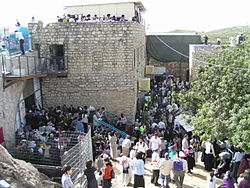Meron
מירון ميرون | |
|---|---|
 The tomb of Rabbi Shimon bar Yochai in Meron | |
| Coordinates: 32°58′55″N 35°26′25″E / 32.98194°N 35.44028°E | |
| Country | |
| District | Northern |
| Council | Merom HaGalil |
| Affiliation | Hapoel HaMizrachi |
| Founded | 2000 BCE (Canaanite city) 1200 BCE (Israelite City) 750 CE (Meiron) 1949 (Israeli moshav) |
| Population (2022)[1] | 1,136 |
Meron (Hebrew: מֵירוֹן, Meron) is a moshav in northern Israel. Located on the slopes of Mount Meron in the Upper Galilee near Safed, it falls under the jurisdiction of Merom HaGalil Regional Council.
Meron is most famous for the tomb of Rabbi Shimon bar Yochai, and is the site of annual mass public commemoration of Lag Ba'Omer. The association of Meron with the ancient Canaanite city of Merom or Maroma is generally accepted by archaeologists. According to Avraham Negev, by the Second Temple period, Merom was known as Meron. Meron is mentioned in the Bible as the site of Joshua's victory over the Canaanite kings.[2] In the 12th century, Benjamin de Tudela visited Meron and described a cave with tombs, believed to hold the remains of Hillel, Shammai, and "twenty of their disciples and other Rabbis". In 1931, Meron consisted of an Arab and Jewish quarter (see Meiron). The current town was founded by the Hapoel HaMizrachi movement in 1949 on the ruins of the depopulated Palestinian village of Meiron, with an initial population of Orthodox soldiers discharged after the war.[3][4][5][6]
In 2022 it had a population of 1,136.[1]
On 30 April 2021, the deadliest civil disaster in the history of Israel occurred at Meron. 45 people were crushed to death while trying to exit through a narrow passage, at the mass gathering to celebrate the holiday of Lag BaOmer.[7]
- ^ a b "Regional Statistics". Israel Central Bureau of Statistics. Retrieved 21 March 2024.
- ^ Mordecai Schreiber, Alvin I. Schiff, Leon Klenicki. The Shengold Jewish Encyclopedia. p. 180
- ^ See below.
- ^ Cite error: The named reference
Morriswas invoked but never defined (see the help page). - ^ Cite error: The named reference
Britannicawas invoked but never defined (see the help page). - ^ Cite error: The named reference
HaTzofewas invoked but never defined (see the help page). - ^ Cite error: The named reference
TOIwas invoked but never defined (see the help page).

